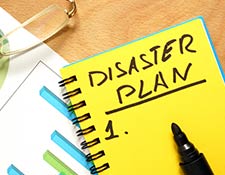
Disaster recovery for health care providers is mandated by the federal government. The U.S. Department of Health and Human Services (HHS) requires that organizations that handle electronic personal health information have a disaster recovery plan in place. HHS Security Standards state that health care organizations must “Establish (and implement as needed) procedures to restore any loss of data.”
Despite this mandate, many health care organizations lack an adequate disaster recovery plan. DrFirst, an e-prescription solutions provider, polled 109 health care providers for a disaster preparedness survey earlier this year. Almost half of those surveyed admitted that their disaster recovery plan isn’t comprehensive enough, and 70% reported having been affected by more than two disasters in the last five years.
Because reacting quickly in an emergency can mean the difference between life and death, hospitals and medical centers must focus on disaster recovery. They need to maintain access to electronic health records (EHRs) and maintain compliance with regulations.
Data as a Lifeline
 Disaster recovery is especially important now that health care providers rely on EHRs to make vital decisions about treatment. Medical teams need to access patients’ medical histories in the field so they can make split-second decisions based on accurate and complete information.
Disaster recovery is especially important now that health care providers rely on EHRs to make vital decisions about treatment. Medical teams need to access patients’ medical histories in the field so they can make split-second decisions based on accurate and complete information.
According to the DrFirst survey, a quarter of health care providers use text messaging to communicate during emergencies. A third rely on telecommunications during a crisis. And while 45% use telehealth to treat patients in a crisis, only 27% feel they have adequate capabilities in place. To leverage telecommunications after a disaster, medical teams need access to a highly available and redundant network.
Protecting the Protectors
Health care organizations are needed during and after a crisis. They can’t afford to fall victim themselves. A flood, wildfire, hurricane, or winter storm can disable hospital systems at a time when the community needs emergency services the most.
Hospital and medical center systems need to be responsive and resilient enough to handle the surge of patients after an emergency. Workloads dramatically increase when a multiple-casualty event occurs, putting a strain on the system and causing bottlenecks and latency or even system failure.
Staying Compliant
 HIPAA regulations put extra pressure on health care organizations to have disaster recovery measures in place. HIPAA requires that personal health information be protected from any unauthorized access. At the same time, patients need secure access to their information.
HIPAA regulations put extra pressure on health care organizations to have disaster recovery measures in place. HIPAA requires that personal health information be protected from any unauthorized access. At the same time, patients need secure access to their information.
A disaster recovery plan is needed to maintain a balance between security and accessibility under adverse conditions.
After a disaster, health care providers must consistently maintain full operations so patients and doctors can provide vital medical treatments. Health care organizations also need to ensure that records are not lost or compromised during downtime. According to HIPAA guidelines, disaster recovery plans must include backup and recovery, as well as regular testing of the disaster recovery plan which includes revision procedures.
Keeping Your Cool in a Crisis
Developing a disaster recovery plan that meets the stringent requirements of the health care industry is not an impossible task. Off-premises data replication protects vital personal health information. Redundancy in the network guards against single points of failure.
FirstLight is experienced in designing disaster recovery solutions for health care institutions. Our fiber optic network provides the redundancy needed to keep information flowing after an emergency. Our cloud and data centers are HIPAA-compliant and undergo yearly audits.
FirstLight’s solutions guarantee that members of a medical team can communicate when the pressure is on. Our high-speed, low-latency network delivers clear and reliable voice and video so health care providers can make the right diagnosis and treatment.
Don’t wait for an emergency. Start enhancing your disaster recovery plan today by teaming up with FirstLight.






















